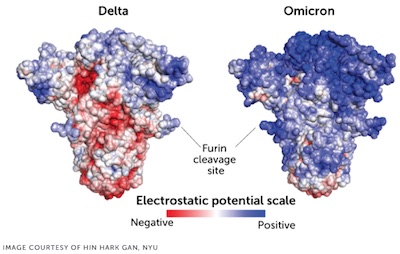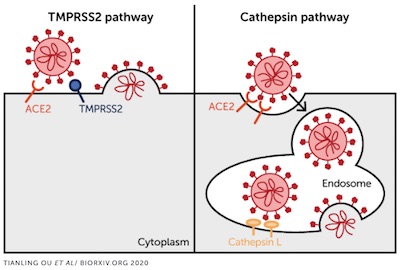On the Difficulty of Making Paxlovid
Tagged:COVID
/
PharmaAndBiotech
/
SomebodyAskedMe
Somebody asked me why we don’t have enough paxlovid or bebtelovimab to go around. After mumbling “something something supply chain”, they ask another question: why can’t we just make more, and faster? Far from being naïve, that’s a very good question.
Why You Should Care
Who cares how fast anybody can make paxlovid or bebtelovimab? Well, you should care: Omicron is not done with us, and the next variant might be immune/vaccine-evasive. In that case, an oral protease inhibitor like paxlovid or the last Omicron/BA.2-effective antibody infusion like bebtelovimab is the difference between living and dying.
 A rather frightening paper out yesterday by Iketani, et al. in
Nature [1] documents that the Omicron/BA.2 variant
(a.k.a. B.1.1.529.2) is indeed resistant to the last then-authorized antibody infusion,
sotrovimab. It does seem to be sensitive to bebtelovimab, but that was only licensed a
few weeks ago and thus has severely limited availability.
A rather frightening paper out yesterday by Iketani, et al. in
Nature [1] documents that the Omicron/BA.2 variant
(a.k.a. B.1.1.529.2) is indeed resistant to the last then-authorized antibody infusion,
sotrovimab. It does seem to be sensitive to bebtelovimab, but that was only licensed a
few weeks ago and thus has severely limited availability.
 But why is Omicron so nasty? An semi-popular science article in Science News by Tina
Saey [2] gives us a quick overview, with pointers to the
primary scientific literature.
But why is Omicron so nasty? An semi-popular science article in Science News by Tina
Saey [2] gives us a quick overview, with pointers to the
primary scientific literature.
Reducing her article to a bullet list and not diving deeply into each paper, I get this summary:
- Since 2021-Dec, Omicron has infected about 90 million people in about 10 weeks, more than all other COVID-19 cases in all of 2020. It’s just that contagious! (Though somewhat less deadly.)
- There are 42 mutations in the spike protein alone, which is important since all the vaccines prime the immune system with the original spike protein.
- Those mutations mean it can infect nearly 10x as many cells as earlier versions. [3]
- The spike protein ends in something like a 3-fingered claw (like a thrint hand?!) to grab the human ACE2 receptor. The Omicron variant curls in the knuckes a bit, somewhat hiding the antibody attack surfaces. [4]
- The Omicron spike protein contains multiple mutations stabilizing it through additional
H bonds, which also help the virus stay together. [5]

- Omicron arrays more polar amino acids in a way to increase electrostatic attraction to
the negative charges displayed by ACE2, 3-5x more so than Delta. [6]

- Omicron uses the TMPRSS2 entry pathway less often [7], favoring instead the cathepsin L endosome method. [8] This means it doesn’t quite merge as well as Delta. But on the other hand, it means cells don’t try to merge with each other and die, leaving the virus with no way to reproduce.
- Both Delta and Omicron get past the IFTIM proteins that guard entry. [9]
- Unvaccinated people are the most likely to get infected: about 3% of the unvaccinated contracted Omicron by January 8, as reported in the CDC COVID Data Tracker as of 2022-Mar-01. [10]
- Omicron is especially good at spreading from cell to cell by preventing immune surveillance, estimated at 5x better than earlier versions. [11] Some of this may be due to the increased positive charge that binds to the ACE2 receptor better, while simultaneously repelling some antibodies.
- Also, some particularly cunning placement of a sugar in Omicron’s spike may guard against the immune system. [12]
- People keep saying Omicron is “milder”, though there are a number of problems in figuring out the extent to which that is true. [13] But vaccines still work pretty well against Omicron [14], as does, to some degree, breakthrough infection. [15] Overall, the UK’s Health Security Agency estimated the risk of death from Omicron at about 60% of the risk from Delta. [16]
- Some reasons for mildness may be that it doesn’t replicate as well in lung [8] and that it triggers interferon responses [17] which invoke antiviral immunity.
Overall, Omicron is a nasty bit of work. Now that the BA.2 variant of Omicron is here, we stand in need of therapies for breakthrough infections, or, Heaven forbid, vaccine-evasive variants.
Because the next coronavirus pandemic, whether it’s SARS or something else, will come. When it does, having something like paxlovid that appears to be active against coronaviruses generally (acting on a highly conserved protease target), will be essential.
MBAs Have Shackled the World in Supply Chains
So… paxlovid still has a long, complicated, global supply chain, eh? Why haven’t we learned anything about the consequences of always doing that yet?
Yeah, I know: it’s cheaper in an NPV sense to stitch together a long, complicated supply chain, because Ricardo’s law of comparative advantage is a thing.
But: a global supply chain only works when (a) countries want to cooperate in trade & currency exchange markets, (b) global shipping works quickly & doesn’t emit so much CO2 that climate change kills everybody, and (c) there’s not a pandemic causing worker shortages with shipping containers piling up in ports.
Have you noticed how all 3 of those propositions are a bit dubious lately?
So these fancy supply chains are like what people in the stock market say of a high-priced stock, that it’s “priced for perfection”. That is: if everything goes pefectly, then this high price is rational; but at the first stumble it’s priced too high and people will sell, causing the share price to crash. Global supply chains are “priced for perfection”, not for robustness in the face of international trade/currency friction, climate change, and pandemics.
What do you think: will the future have more or less of international friction, climate change, and pandemics? If you think more, then you should also believe we need to shorten supply chains and do more domestic production even if it’s at higher prices. Not complete autarky, just shorter supply chains and more domestic production.
Robustness is not free, after all.
Some things are hard to make, others slow, and some both
I don’t, and won’t, read Twitter. The short attention span takes of the uninformed are not useful to anybody, and that’s most of what Twitter is about. Sure, there are a few entertaining souls, and a few well informed sorts. But I wait for other people to find those, and bring them to my attention in a blog or an article or something.
The AP tweet above is one such, indicating that somebody had done a small bit of digging – basically asking Pfizer – into why paxlovid takes a long time. It’s really interesting and we’re going to move to the AP article itself next, but… do not, under any circumstances, read the reply tweets! The level of stupidity is well beyond toxic:
- Multiple assertions that this is just a cash cow for Pfizer to get money from dying people, and anybody who disagrees is a stockholder.
- Sly assertions that vaccines “just don’t work”, so somehow this won’t work either.
- Even more blatant assertions that the Pfizer vaccine is somehow harmful, so one shouldn’t take a pill from the same company.
- Repeated, and I mean repeated, implications that somehow both paxlovid and molnupiravir are just ivermectin, studiously rebunked despite repeated debunking. These really seem to be fact-proof beliefs on the dimwitted right.
- Utterly bogus assertions that a viral therapeutic “isn’t needed”, and “COVID’s over”.
- A few really weird off-topic religious assertions that aren’t even internally consistent.
- Outlandish claims that side-effects are being hidden, similar to outlandish claims of hidden side-effects in vaccines.
- Wild assertions that vacines cause Parkinson’s-like body tremors, so maybe this medication will cause some horrible side-effect.
…and so on, ad nauseam. Now you know why I refuse to touch Facebook or Twitter.

Having re-learned that valuable lesson, let’s move on the the actual journalism, curated by a science journalist showing signs of actual sanity. [18]
Ironically, the first thing I learned is that Pfizer-folk pronounce paxlovid with the accent on the 2nd syllable (“paxLOvid”), whereas out here in the wild I’ve only heard the accent on the first syllable (“PAXlovid”). Would that this were our main problem!
- Paxlovid is actually a pair of drugs,
taken together:
- Nirmatrelvir is the novel protease inhibitor which is the current pain in the rear end to manufacture in quantity.
- Ritonavir is taken with it, mostly to block the liver enzyme CYP3A which would break down nirmatrelvir, so it makes nirmatrelvir stay resident in the body longer. It’s also a mild protease inhibitor on it’s own, but the main effect is as an adjuvant to make other drugs stronger. That’s its role in the current AIDS/HepC cocktails, and also the main problem that it interacts with all kinds of other drugs. Still, it’s already manufactured in quantity, so it’s not the supply problem.
- It initially took about 9 months to synthesize nirmatrelvir, though after some process optimization (somebody’s losing sleep over this in a serious way!), that’s now down to about 7 months. You can make mRNA vaccine doses faster than this!
- It takes about 3 months just to do the chemical synthesis to get the starting materials. Some reactions take days to complete, and have to be held rigorously at a certain temperature.
- There is also a gnarly supply chain problem. This is partly because MBAs have stitched
together global supply chains that are marginally cheaper in good times (but fail
utterly in stressed times; they are “priced for perfection” and perfection only!). But
it’s also because you’d only build a centralized, specialized plant if you knew you were
going to sell in volume for enough years to pay back the maybe $1 billion cost in
building the plant. So the different components to the reaction network get made in
different places, and shipped around a lot.
- Paxlovid is made in 20 sites in 10 countries, so it depends a lot on air freight!
- By comparison, Merck’s molnupiravir is made at 17 sites in 8 countries, so pretty much the same story.
- The 7-9 month synthesis/packaging pipeline is actually shorter than a number of other drugs, so this is not especially unusual. Though it is especially frustrating!
Still, with all that: Pfizer’s Chief Global Supply Officer, Mike McDermott says in the interview above that they expect to have 30 million courses available by mid-2022 and 120 million by the end of 2022.
That’s… not a lot, when shared among 8 billion people. Though my hope we’ll share is perhaps yet another celestial delusion about what telestial people will actually do.
Still: things are getting better, with higher vaccination rates (glacially slowly) and treatment alternatives like paxlovid/bebtelovimab/molnupiravir (slowly improving supply). If we somehow learn to get those universally available even to the developing world (or the poor in the developed world), then maybe we’ll have learned a number of important lessons. Only some of them will be about COVID-19.
The Weekend Conclusion

The Christian ideal has not been tried and found wanting; it has been found difficult and left untried. — G. K. Chesterton, What’s Wrong with the World? (1910), Chapter 5.
 (Sure, Chesterton’s a bit preachy. Sometimes more than a bit. But he’s also brilliantly
funny. [19] For example, try out
The Man Who Was Thursday.
Just see if the opening scene of law enforcement vs terrorists duelling by poetry in a
park, followed by adjournment to the restaurant in the bad guy’s HQ draws your interest.)
(Sure, Chesterton’s a bit preachy. Sometimes more than a bit. But he’s also brilliantly
funny. [19] For example, try out
The Man Who Was Thursday.
Just see if the opening scene of law enforcement vs terrorists duelling by poetry in a
park, followed by adjournment to the restaurant in the bad guy’s HQ draws your interest.)
Making paxlovid has also been found difficult… but worthwhile. We’re trying.
Now if only we can also try to deliver universal health care to all of humanity, before we breed a more serious variant that starts wiping us out.
Oh, and let’s not start a nuclear war, ok? (Just in case Putin reads this. Worth a shot, anyway.)
Notes & References
1: S Iketani, et al., “Antibody evasion properties of SARS-CoV-2 Omicron sublineages”, Nature, 2022-Mar-03. DOI: 10.1038/s41586-022-04594-4. ↩
2: TH Saey, “How omicron’s mutations make it the most infectious coronavirus variant yet”, Science News, 2022-Mar-01. ↩
3: X Zhang, et al., “SARS-CoV-2 Omicron strain exhibits potent capabilities for immune evasion and viral entrance”, Sig Transd Targ Ther 6:430, 2021-Dec-07. DOI: 10.1038/s41392-021-00852-5. ↩
4: S M-C Gobeil, et al., “Structural diversity of the SARS-CoV-2 Omicron spike”, bioRχiv, 2022-Jan-06. DOI: 10.1101/2022.01.25.477784. ↩
5: D Mannar, et al., “SARS-CoV-2 Omicron variant: Antibody evasion and cryo-EM structure of spike protein–ACE2 complex”, Science 375:6582, 760-764, 2022-Jan-20. DOI: 10.1126/science.abn7760. ↩
6: HH Gan, et al., “Omicron Spike protein has a positive electrostatic surface that promotes ACE2 recognition and antibody escape”, bioRχiv, 2022-Feb-14. DOI: 10.1101/2022.02.13.480261. ↩
7: B Meng, et al., “Altered TMPRSS2 usage by SARS-CoV-2 Omicron impacts tropism and fusogenicity”, Nature, accelerated review articles, 2022-Jan-26. DOI: 10.1038/s41586-022-04474-x. ↩
8: KPY Hui, et al., “SARS-CoV-2 Omicron variant replication in human bronchus and lung ex vivo”, Nature accelerated review articles, 2022-Jan-27. DOI: 10.1038/s41586-022-04479-6. ↩
9: TP Peacock, et al., “The SARS-CoV-2 variant, Omicron, shows rapid replication in human primary nasal epithelial cultures and efficiently uses the endosomal route of entry”, bioRχiv, 2022-Jan-03. DOI: 10.1101/2021.12.31.474653. ↩
10: CDC Staff, “Rates of COVID-19 Cases and Deaths by Vaccination Status”, CDC COVID Data Tracker, 2022-Mar-01. ↩
11: C Zeng, et al., “Neutralization and Stability of SARS-CoV-2 Omicron Variant”, bioRχiv, 2021-Dec-20. DOI: 10.1101/2021.12.16.472934. ↩
12: DS Roberts, et al., “Distinct Core Glycan and O-Glycoform Utilization of SARS-CoV-2 Omicron Variant Spike Protein RBD Revealed by Top-Down Mass Spectrometry”, bioRχiv, 2022-Feb-10. DOI: 10.1101/2022.02.09.479776. ↩
13: RP Bhattacharyya, et al., “Challenges in Inferring Intrinsic Severity of the SARS-CoV-2 Omicron Variant”, N Engl J Med 386:e14, 2022-Feb-17. DOI: 10.1056/NEJMp2119682. ↩
14: JM Ferdinands, et al., “Waning 2-Dose and 3-Dose Effectiveness of mRNA Vaccines Against COVID-19–Associated Emergency Department and Urgent Care Encounters and Hospitalizations Among Adults During Periods of Delta and Omicron Variant Predominance — VISION Network, 10 States, August 2021–January 2022”, CDC Morbidity and Mortality Weekly Report, 71:7, 255-263, 2022-Feb-18. DOI: 10.15585/mmwr.mm7107e2. ↩
15: JP Evans, et al., “Neutralizing antibody responses elicited by SARS-CoV-2 mRNA vaccination wane over time and are boosted by breakthrough infection”, Science Translational Medicine, 2022-Feb-15. DOI: 10.1126/scitranslmed.abn8057. ↩
16: UK Health Security Agency, “SARS-CoV-2 variants of concern and variants under investigation in England”, Technical Briefing 36, 2022-Feb-11. ↩
17: D Bojkova, et al., “Reduced interferon antagonism but similar drug sensitivity in Omicron variant compared to Delta variant of SARS-CoV-2 isolates”, Cell Research 32:319-321, 2022-Jan-21. ↩
18: T Murphy, “EXPLAINER: Why Pfizer needs time to make COVID-19 treatment”, AP News, 2022-Mar-02. ↩
19: The London Times in 1908 asked writers for essays on the subject of “What is Wrong with the World?” Chesterton’s reply was allegedly this letter:
Dear Sirs:
I am.
Sincerely yours,
G. K. Chesterton
There’s apparently no actual evidence this happened, at least not literally as told. But anybody who’s read more than a bit of Chesterton will find it utterly plausible.
 There was, however, a letter by Chesterton to the Daily News of 1905-Aug-16, dug up by Jordan Poss, saying something similar, abeit more prolix:
There was, however, a letter by Chesterton to the Daily News of 1905-Aug-16, dug up by Jordan Poss, saying something similar, abeit more prolix:
In one sense, and that the eternal sense, the thing is plain. The answer to the question “What is Wrong?” is, or should be, “I am wrong.” Until a man can give that answer his idealism is only a hobby.


Gestae Commentaria
Comments for this post are closed pending repair of the comment system, but the Email/Twitter/Mastodon icons at page-top always work.